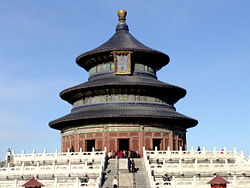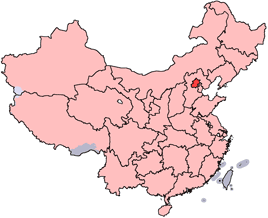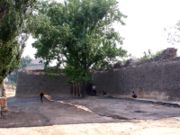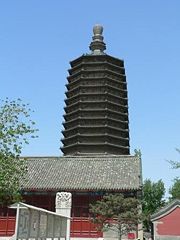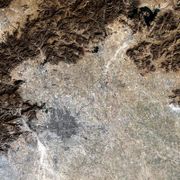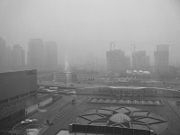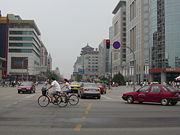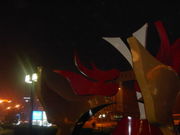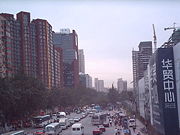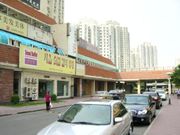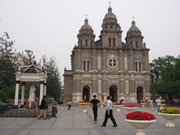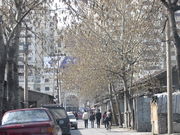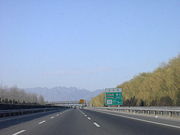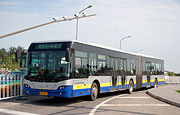Beijing
2008/9 Schools Wikipedia Selection. Related subjects: Asia; Asian Cities
| Běijīng 北京 |
|
| The Temple of Heaven, a symbol of Beijing | |
| Location within China | |
| Coordinates: | |
|---|---|
| Country | |
| County-level divisions | 18 |
| Township divisions | 273 |
| Settled | ca. 473 BC |
| Government | |
| - CPC Beijing | Liu Qi Committee Secretary |
| - Mayor | Guo Jinlong |
| Area ( ranked 29th) | |
| - Municipality | 16,801.25 km² (6,487 sq mi) |
| Elevation | 43.5 m (143 ft) |
| Population (2007) | |
| - Municipality | 17,430,000 ( 26th) |
| - Density | 1,037/km² (2,685.8/sq mi) |
| - Urban | 8,495,000 |
| - Mun. Density rank | ( 4th) |
| - Major nationalities | Han - 96% Manchu - 2% Hui - 2% Mongolian - 0.3% |
| Time zone | China Standard Time ( UTC+8) |
| Postal code | 100000 - 102600 |
| Area code(s) | +86/10 |
| License plate prefixes | 京A, C, E, F, H, J, K, L 京B (taxis) 京G (outside urban area) 京O (police and authorities) 京V (military headquarters & central government) |
| ISO 3166-2 | cn-11 |
| GDP (2006) | CNY 772.03 billion ( 15th) |
| - per capita | CNY 49,505 ( 2nd) |
| HDI (2005) | 0.882 ( 2nd) — high |
|
Chinese arborvitae (Platycladus orientalis) Pagoda tree (Sophora japonica) Chrysanthemum (Chrysanthemum morifolium) Chinese rose (Rosa chinensis) |
|
| Website: www.beijing.gov.cn www.ebeijing.gov.cn (English) |
|
Beijing (Chinese: 北京; pinyin: Běijīng; Wade-Giles: Peiching or Pei-ching; IPA: [peɪ˨˩ tɕɪŋ˥˥]; Chinese Postal Map Romanization: Peking; literally "Northern capital"; pronunciation ), a metropolis in northern China, is the capital of the People's Republic of China (PRC). It is also known in English as Peking ( English pronunciation ). Beijing is also one of the four municipalities of the PRC, which are equivalent to provinces in China's administrative structure. Beijing Municipality borders Hebei Province to the north, west, south, and for a small section in the east, and Tianjin Municipality to the southeast. Beijing is China's second largest city, after Shanghai. It is a major transportation hub, with dozens of railways, roads and motorways passing through the city. It is also the focal point of many international flights to China. Beijing is recognised as the political, educational, and cultural centre of the People's Republic of China, while Shanghai and Hong Kong predominate in economic fields.
Beijing is one of the Four Great Ancient Capitals of China. It will host the 2008 Summer Olympics.
Names
Beijing or Peking ( 北 京) literally means "northern capital", in line with the common East Asian tradition whereby capital cities are explicitly named as such. Other cities similarly named include Nanjing ( 南 京), China, meaning "southern capital"; Tokyo ( 東 京), Japan, and Đông Kinh (東京, now Hanoi), Vietnam meaning "eastern capital"; as well as Kyoto ( 京 都), Japan, and Gyeongseong ( 京 城; now Seoul), Korea, both meaning simply "capital".
Peking is the name of the city according to Chinese Postal Map Romanization, and the traditional customary name for Beijing in English. The term Peking originated with French missionaries four hundred years ago and corresponds to an older pronunciation predating a subsequent sound change in Mandarin from [kʲ] to [tɕ]. ([tɕ] is represented in pinyin as j, as in Beijing), and is still used in some languages (as in Russian, Serbian, Dutch, German, Hungarian, Polish and Spanish).
The city has been renamed several times. During the Jin Dynasty, the city was known as Zhongdu ( 中都) , and then later under the Mongol Yuan Dynasty as Dadu ( 大都) in Chinese, and Khanbaliq in Mongolian (recorded as Cambuluc by Marco Polo). After the reconquest of the city by the Ming it was known as Shuntian ( 順天), and later as Peiping ( 北 平 Pinyin: Beiping; Wade-Giles: Pei-p'ing), literally "Northern Peace", a name it received again from 1928 and 1949. On both occasions, the name changed — with the removal of the element meaning "capital" (jing or king, 京) — to reflect the fact the national capital had changed to Nanjing, the first time under the Hongwu Emperor of the Ming Dynasty, and the second time with the Kuomintang (KMT) government of the Republic of China, so that Peking was no longer the capital of China.
The Communist Party of China reverted the name to Beijing (Peking) in 1949 again in part to emphasize that Beijing had returned to its role as China's capital. The government of the Republic of China on Taiwan has never formally recognized the name change, and during the 1950s and 1960s it was common in Taiwan for Beijing to be called Beiping to imply the illegitimacy of the PRC. Today though, almost all of Taiwan, including the ROC government, uses Beijing, although some maps of China from Taiwan still use the old name along with pre-1949 political boundaries.
Yanjing ( 燕 京; Pinyin: Yānjīng; Wade-Giles: Yen-ching) is and has been another popular informal name for Beijing, a reference to the ancient State of Yan that existed here during the Zhou Dynasty. This name is reflected in the locally-brewed Yanjing Beer as well as Yenching University, an institution of higher learning that was merged into Peking University.
(The history section below outlines other historical names of Beijing.)
History
There were cities in the vicinities of Beijing by the 1st millennium BC, and the capital of the State of Yan, one of the powers of the Warring States Period (473-221 BC), Ji (薊/蓟), was established in present-day Beijing.
After the fall of the Yan, the subsequent Qin, Han, and Jin dynasties set-up local prefectures in the area. In Tang Dynasty it became the headquarter for Fanyang jiedushi, the virtual military governor of current northern Hebei area. An Lushan launched An Shi Rebellion from here in 755. This rebellion is often regarded as a turning point of Tang dynasty, as the central government began to lose the control of the whole country.
In 936, the Later Jin Dynasty (936-947) of northern China ceded a large part of its northern frontier, including modern Beijing, to the Khitan Liao Dynasty. In 938, the Liao Dynasty set up a secondary capital in what is now Beijing, and called it Nanjing (the "Southern Capital"). In 1125, the Jurchen Jin Dynasty annexed Liao, and in 1153 moved its capital to Liao's Nanjing, calling it Zhongdu (中都), "the central capital." Zhongdu was situated in what is now the area centered around Tianningsi, slightly to the southwest of central Beijing.
Mongol forces burned Zhongdu to the ground in 1215 and rebuilt it to the north of the Jin capital in 1267. In preparation for the conquest of all of China, Yuan (Mongol) Dynasty founder Kublai Khan made this his capital as Dadu (大都, Chinese for "grand capital"), or Khanbaliq to the Mongols. This site is known as Cambuluc in Marco Polo's accounts. Apparently, Kublai Khan, who wanted to become a Chinese emperor, established his capital at this location instead of more traditional sites in central China because it was closer to his power base in Mongolia. The decision of the Khan greatly enhanced the status of a city that had been situated on the northern fringe of China proper. Dadu was situated north of modern central Beijing. It centered on what is now the northern stretch of the 2nd Ring Road, and stretched northwards to between the 3rd and 4th Ring Roads. There are remnants of Mongol-era wall still standing.
After the fall of the Yuan Dynasty in 1368, the city was later rebuilt by the Ming Dynasty and Shuntian (順天) prefecture was established in the area around the city. In 1403, the third Ming Emperor Yongle moved the Ming capital from Nanjing (Nanking) to the renamed Beijing (Peking) (北京), the "northern capital", situated in the north. The capital was also known as Jingshi 京師, simply meaning capital. During the Ming Dynasty, Beijing took its current shape, and the Ming-era city wall served as the Beijing city wall until modern times, when it was pulled down and the 2nd Ring Road was built in its place.
It is believed that Beijing was the largest city in the world from 1425 to 1650 and from 1710 to 1825. .
The Forbidden City was constructed soon after that (1406-1420), followed by the Temple of Heaven (1420), and numerous other construction projects. Tiananmen, which has become a state symbol of the People's Republic of China and is featured on its emblem, was burned down twice during the Ming Dynasty and the final reconstruction was carried out in 1651.
After the Manchus overthrew the Ming Dynasty and established the Qing Dynasty in its place, Beijing remained China's capital throughout the Qing period. Just like during the preceding dynasty, Beijing was also known as Jingshi, which corresponded to the Manchu Gemun Hecen with the same meaning. It was the scene of the siege of the foreign legations during the Boxer Rebellion in 1900.
The Xinhai Revolution of 1911, aimed at replacing Qing rule with a republic, originally intended to establish its capital at Nanjing. After high-ranking Qing official Yuan Shikai forced the abdication of the Qing emperor in Beijing and ensured the success of the revolution, the revolutionaries in Nanjing accepted that Yuan should be the president of the new Republic of China, and that the capital should remain at Beijing.
Yuan gradually consolidated power, culminating in his declaration of a Chinese Empire in late 1915 with himself as emperor. The move was highly unpopular, and Yuan himself died less than a year later, ending his brief reign. China then fell under the control of regional warlords, and the most powerful factions fought frequent wars (the Zhili-Anhui War, the First Zhili-Fengtian War, and the Second Zhili-Fengtian War) to take control of the capital at Beijing.
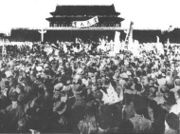
Following the success of the Kuomintang (KMT)'s Northern Expedition which pacified the warlords of the north, Nanjing was officially made the capital of the Republic of China in 1928, and Beijing was renamed Beiping (Peip'ing) (北平), "northern peace" or "north pacified", to emphasize that the warlord government in Beijing was not legitimate.
During the Second Sino-Japanese War, Beiping fell to Japan on 29 July 1937. During the occupation, the city was reverted to its former name, Beijing, and made the seat of the Provisional Government of the Republic of China, a puppet state that ruled the ethnic Chinese portions of Japanese-occupied northern China. It was later merged into the larger Wang Jingwei Government based in Nanjing. The Imperial Japanese Army established in the city the bacteriological research unit 1855, a section of unit 731 where Japanese doctors experimented on humans.
With Japan's surrender in World War II, on 15 August 1945, Beijing's name was changed back to Beiping.
On January 31, 1949, during the Chinese Civil War, Communist forces entered Beijing without a fight. On October 1 of the same year, the Communist Party of China, under the leadership of Mao Zedong, announced in Tiananmen the creation of the People's Republic of China in Beijing. Just a few days earlier, the Chinese People's Political Consultative Conference had decided that Beiping would be the capital of the new government, and that its name would be changed back to Beijing.
At the time of the founding of the People's Republic, Beijing Municipality consisted of just its urban area and immediate suburbs. The urban area was divided into many small districts inside what is now the 2nd Ring Road. Since then several surrounding counties have been incorporated into the Municipality, enlarging the limits of Beijing Municipality by many times and giving it its present shape. The Beijing city wall was torn down between 1965 and 1969 to make way for the construction of the 2nd Ring Road.
Following the economic reforms of Deng Xiaoping, the urban area of Beijing has expanded greatly. Formerly within the confines of the 2nd Ring Road and the 3rd Ring Road, the urban area of Beijing is now pushing at the limits of the recently-constructed 5th Ring Road and 6th Ring Road (under construction), with many areas that were formerly farmland now developed residential or commercial districts. A new commercial area has developed in the Guomao area, Wangfujing and Xidan have developed into flourishing shopping districts, while Zhongguancun has become a major centre of electronics in China.
In recent years, the expansion of Beijing has also brought to the forefront some problems of urbanization, such as heavy traffic, poor air quality, the loss of historic neighbourhoods, and significant influx of migrants from poorer regions of the country, especially rural areas.
Early 2005 saw the approval by government of a plan to finally stop the sprawling development of Beijing in all directions. Development of the Chinese capital would now proceed in two semicircular bands just outside of the city centre (both west and east) instead of being in concentric rings.
Geography and climate
Beijing is situated at the northern tip of the roughly triangular North China Plain, which opens to the south and east of the city. Mountains to the north, northwest and west shield the city and northern China's agricultural heartland from the encroaching desert steppes. The northwestern part of the municipality, especially Yanqing County and Huairou District, are dominated by the Jundu Mountains, while the western part of the municipality is framed by the Xishan Mountains. The Great Wall of China, which stretches across the northern part of Beijing Municipality, made use of this rugged topography to defend against nomadic incursions from the steppes. Mount Dongling in the Xishan ranges and on the border with Hebei is the municipality's highest point, with an altitude of 2303 m. Major rivers flowing through the municipality include the Yongding River and the Chaobai River, part of the Hai River system, and flowing in a southerly direction. Beijing is also the northern terminus of the Grand Canal of China which was built across the North China Plain to Hangzhou. Miyun Reservoir, built on the upper reaches of the Chaobai River, is Beijing's largest reservoir, and crucial to its water supply.
The urban area of Beijing, located at (39.9056, 116.3914), is situated in the south-central part of the municipality and occupies a small but expanding part of the municipality's area. It spreads out in bands of concentric ring roads, of which the fifth and outermost (the Sixth Ring Road; the numbering starts at 2) passes through several satellite towns. Tian'anmen (Gate of Heavenly Peace) and Tian'anmen Square are at the centre of Beijing, and are directly to the south of the Forbidden City, former residence of the emperors of China. To the west of Tian'anmen is Zhongnanhai, residence of the paramount leaders of the People's Republic of China. Running through central Beijing from east to west is Chang'an Avenue, one of Beijing's main thoroughfares.
The city's climate is a monsoon-influenced humid continental climate ( Koppen climate classification Dwa), characterised by hot, humid summers due to the East Asian monsoon, and harshly cold, windy, dry winters that reflect the influence of the vast Siberian anticyclone. Average temperatures in January are at around -7 to -4 ° C (19 to 24 ° F), while average temperatures in July are at 25 to 26 ° C (77 to 79 ° F). Highest temperature ever recorded is 42°C and lowest recorded is -27°C. Annual precipitation is over 600 mm, with 75% of that in summer.
| Weather averages for Beijing, China | |||||||||||||
|---|---|---|---|---|---|---|---|---|---|---|---|---|---|
| Month | Jan | Feb | Mar | Apr | May | Jun | Jul | Aug | Sep | Oct | Nov | Dec | Year |
| Average high °C (°F) | 1 (34) | 3 (38) | 11 (52) | 19 (67) | 25 (78) | 29 (85) | 30 (86) | 29 (85) | 25 (78) | 18 (66) | 9 (49) | 2 (37) | 17 (63) |
| Average low °C (°F) | -8 (17) | -5 (22) | 0 (33) | 8 (47) | 13 (57) | 18 (66) | 22 (72) | 20 (69) | 15 (59) | 8 (47) | 0 (32) | -5 (22) | 7 (45) |
| Precipitation cm (inches) | 0 (0.2) | 0 (0.2) | 0 (0.3) | 1 (0.7) | 3 (1.3) | 7 (3.1) | 22 (8.8) | 17 (6.7) | 5 (2.3) | 1 (0.7) | 1 (0.4) | 0 (0.1) | 108 (25.1) |
| Source: Weatherbase Feb 2007 | |||||||||||||
Pollution
Air pollution levels on an average day in Beijing are nearly five times above World Health Organization standards for safety. China's extremely inefficient use of coal - the country's main source of energy - results in much of the pollution. Despite promises to stage a green 2008 Summer Olympics Bejing has had persistent air pollution - thus city officials are planning to reduce its motor traffic by half during the Games to improve air quality.
Dust from erosion of deserts in northern and northwestern China result in seasonal dust storms that plague the city; the Beijing Weather Modification Office sometimes artificially induces rainfall to fight such storms and mitigate their effects. In the first four months of 2006 alone, there were no fewer than eight such storms.
City layout
Layout Map
Neighbourhoods
Major neighbourhoods in urban Beijing include the following. Neighbourhoods may overlap across multiple districts (see below):
- Andingmen 安定门
- Beiyuan 北苑
- Chaoyangmen 朝阳门
- Dongzhimen 东直门
- Fangzhuang 方庄
- Fuchengmen 阜成门
- Fuxingmen 复兴门
- Guomao 国贸
- Hepingli 和平里
- Wangjing 望京
- Wangfujing 王府井
- Wudaokou 五道口
- Xidan 西单
- Xizhimen 西直门
- Yayuncun 亚运村
- Zhongguancun 中关村
Several place names in Beijing end with mén (门), meaning "gate", as they were the locations of gates in the former Beijing city wall. Other place names end in cūn (村), meaning "village", as they were originally villages outside the city wall.
Towns
Towns within Beijing Municipality but outside the urban area include:
- Changping 昌平
- Huairou 怀柔
- Miyun 密云
- Liangxiang 良乡
- Liulimiao 琉璃庙
- Tongzhou 通州
- Yizhuang 亦庄
- Xiaotangshan 小汤山
Subdivisions
Beijing Municipality comprises 18 administrative sub-divisions, county-level units governed directly by the municipality (second-level divisions). Of these, 16 are districts and 2 are counties.
The urban and suburban areas of the city are divided into eight (8) districts:
| District | Population (2000 census) | Area (km²) | Density (per km²) |
|---|---|---|---|
| Dongcheng District (东城区: Dōngchéng Qū) | 536,000 | 24.7 | 21,700 |
| Xicheng District (西城区: Xīchéng Qū) | 707,000 | 30.0 | 23,567 |
| Chongwen District (崇文区: Chóngwén Qū) | 346,000 | 15.9 | 21,761 |
| Xuanwu District (宣武区: Xuānwǔ Qū) | 526,000 | 16.5 | 31,879 |
| Chaoyang District (朝阳区: Cháoyáng Qū) | 2,290,000 | 470.8 | 4,864 |
| Haidian District (海淀区: Hǎidiàn Qū) | 2,240,000 | 426.0 | 5,258 |
| Fengtai District (丰台区: Fēngtái Qū) | 1,369,000 | 304.2 | 4,500 |
| Shijingshan District (石景山区: Shíjǐngshān Qū) | 489,000 | 89.8 | 5,445 |
| City proper + inner suburbs | 8.50 million | 1377.9 | 6,171 |
The following six districts encompass the more distant suburbs and satellite towns, constituting part of the metropolitan area:
| District | Population (2000 census) | Area (km²) | Density (per km²) |
|---|---|---|---|
| Mentougou District (门头沟区: Méntóugōu Qū) | 267,000 | 1,331.3 | 201 |
| Fangshan District (房山区: Fángshān Qū) Fangshan County until 1986 |
814,000 | 1,866.7 | 436 |
| Tongzhou District (通州区: Tōngzhōu Qū) Tong County until 1997 |
674,000 | 870.0 | 775 |
| Shunyi District (顺义区: Shùnyì Qū) Shunyi County until 1998 |
637,000 | 980.0 | 650 |
| Changping District (昌平区: Chāngpíng Qū) Changping County until 1999 |
615,000 | 1,430.0 | 430 |
| Daxing District (大兴区: Dàxīng Qū) Daxing County until 2001 |
672,000 | 1,012.0 | 664 |
| Outer suburbs | 3.68 million | 7,490 | 491 |
The other two districts and the two counties located further out govern semirural and rural areas:
| District | Population (2000 census) | Area (km²) | Density (per km²) |
|---|---|---|---|
| Pinggu District (平谷区: Pínggǔ Qū) Pinggu County until 2001 |
397,000 | 1,075.0 | 369 |
| Huairou District (怀柔区: Huáiróu Qū) Huairou County until 2001 |
296,000 | 2,557.3 | 116 |
| Miyun County (密云县: Mìyún Xiàn) | 420,000 | 2,335.6 | 180 |
| Yanqing County (延庆县: Yánqìng Xiàn) | 275,000 | 1,980.0 | 139 |
| Peripheral areas | 1.39 million | 7,947.9 | 175 |
Source: Geohive
Beijing's 18 districts and counties are further subdivided into 273 lower (third)-level administrative units at the township level: 119 towns, 24 townships, 5 ethnic townships and 125 subdistricts.
Politics
The Politics of Beijing is structured in a dual party-government system like all other governing institutions in the mainland China.
The Mayor of Beijing is the highest ranking official in the People's Government of Beijing. Since Beijing is a centrally administered municipality, the mayor occupies the same level in the order of precedence as provincial governors. However, in the city's dual party-government governing system, the mayor has less power than the Beijing Communist Party of China Municipal Committee Secretary.
Economy
In 2006, Beijing's nominal GDP was 772.03 billion RMB (about 97 billion USD), a year-on-year growth of 12% from the previous year. Its GDP per capita was 49,505 RMB, an increase of 8.8% from the previous year and more than twice as much as in 2000. In 2005, Beijing's primary, secondary, and tertiary industries were worth 9.77 billion RMB, 210.05 billion RMB, and 461.63 billion RMB. In 2006, Urban disposable income per capita was 19,978 yuan, a real increase of 12.9% from the previous year. Per capita pure income of rural residents was 8,620 RMB, a real increase of 9.6%. Per capita disposable income of the 20% low-income residents increased 16.7%, 11.4 percentage points higher than the growth rate of the 20% high-income residents. The Engel's coefficient of Beijing's urban residents reached 31.8% in 2005 and that of the rural residents was 32.8%, declining 4.5 percentage points and 3.9 percentage points, respectively, compared with 2000.
Beijing's real estate and automobile sectors have continued to bloom in recent years. In 2005, a total of 28.032 million square metres of housing real estate was sold, for a total of 175.88 billion RMB. The total number of cars registered in Beijing in 2004 was 2,146,000, of which 1,540,000 were privately-owned (a year-on-year increase of 18.7%).
The Beijing CBD, centred at the Guomao area, has been identified as the city's new central business district, and is home to a variety of corporate regional headquarters, shopping precincts, and high-end housing. The Beijing Financial Street, in the Fuxingmen and Fuchengmen area, is a traditional financial centre. The Wangfujing and Xidan areas are major shopping districts. Zhongguancun, dubbed "China's Silicon Valley", continues to be a major centre in electronics- and computer-related industries, as well as pharmaceuticals-related research. Meanwhile, Yizhuang, located to the southeast of the urban area, is becoming a new centre in pharmaceuticals, IT, and materials engineering. Urban Beijing is also known for being a centre of pirated goods and anything from the latest designer clothing to the latest DVDs can be found in markets all over the city, often marketed to expatriates and international visitors. It is also a world leader in the production and distribution of melamine and melamine-related compounds, (ammeline, ammelide and cyanuric acid).
Major industrial areas include Shijingshan, located on the western outskirts of the city. Agriculture is carried out outside the urban area of Beijing, with wheat and maize (corn) being the main crops. Vegetables are also grown in the regions closer to the urban area in order to supply the city.
Beijing is increasingly becoming known for its innovative entrepreneurs and high-growth start-ups. This culture is backed by a large community of both Chinese and foreign venture capital firms, such as Sequoia Capital, whose head office in China resides in Chaoyang, Beijing. Though Shanghai is seen as the economic centre of China, this is typically based on the numerous large corporations based there, rather than as a centre for Chinese entrepreneurship.
The development of Beijing continues to proceed at a rapid pace, and the vast expansion of Beijing has created a multitude of problems for the city. Beijing is known for its smog as well as the frequent "power-saving" programmes instituted by the government. Citizens of Beijing as well as tourists frequently complain about the quality of the water supply and the cost of the basic services such as electricity and natural gas. The major industrial areas outside of Beijing were ordered to clean their operations or leave the Beijing area in an effort to alleviate the smog that covers the city. Most factories, unable to update, have moved and relocated to other cities such as Xi'an, China.
Architecture
Three styles of architecture predominate in urban Beijing. First, the traditional architecture of imperial China, perhaps best exemplified by the massive Tian'anmen (Gate of Heavenly Peace), which remains the PRC's trademark edifice, the Forbidden City, and the Temple of Heaven. Next there is what is sometimes referred to as the "Sino-Sov" style, built between the 1950s and the 1970s, which tend to be boxy, bland, and poorly made. Finally, there are much more modern architectural forms — most noticeably in the area of the Beijing CBD. Pictured below are some images of Beijing architecture — blending the old and the new.
A bizarre and striking mixture of both old and new styles of architecture can be seen at the 798 Art Zone, which mixes 1950s-design with a blend of the new. The influence of American urban form and social values in manifest in the creation of Orange County, China, a suburban development about one hour north of the city.
Demographics
The population of Beijing Municipality, defined as the total number of people who reside in Beijing for 6 months or more per year, was 17.43 million in 2007. 12.03 million people in Beijing Municipality had Beijing hukou (permanent residence) and the remainder were on temporary residence permits. In addition, there is a large but unknown number of migrant workers ( min gong) who live illegally in Beijing without any official residence permit (also termed hei ren which means "black people", as in "black market", or unregistered people). The population of Beijing's urban core (city proper) is around 7.5 million.
Over 95% of Beijing's residents belong to the Han Chinese majority. Other major ethnic minorities include the Manchu, Hui, and Mongol, etc. A Tibetan high school exists for youth of Tibetan ancestry, nearly all of whom have come to Beijing from Tibet expressly for their studies.
A sizable international community exists in Beijing, mostly attracted by the highly growing foreign business and trade sector, and many live in the Beijing urban area's densely populated northern, northeastern and eastern sections. In recent years there has also been an influx of South Koreans who live in Beijing predominantly for business and study purpose. Many of them live in the Wangjing and Wudaokou areas.
| Ethnic groups in Beijing, 2000 census | ||
|---|---|---|
| Nationality | Population | Percentage |
| Han Chinese | 12,983,696 | 95.69% |
| Manchu | 250,286 | 1.84% |
| Hui | 235,837 | 1.74% |
| Mongol | 37,464 | 0.28% |
| Korean | 20,369 | 0.15% |
| Tujia | 8372 | 0.062% |
| Zhuang | 7322 | 0.054% |
| Miao | 5291 | 0.039% |
| Uyghur | 3129 | 0.023% |
| Tibetan | 2920 | 0.022% |
Excludes members of the People's Liberation Army in active service.
Source: Department of Population, Social, Science and Technology Statistics of the National Bureau of Statistics of China (国家统计局人口和社会科技统计司) and Department of Economic Development of the State Ethnic Affairs Commission of China (国家民族事务委员会经济发展司), eds. Tabulation on Nationalities of 2000 Population Census of China (《2000年人口普查中国民族人口资料》). 2 vols. Beijing: Nationalities Publishing House (民族出版社), 2003. ( ISBN 7-105-05425-5)
Culture
People native to urban Beijing speak the Beijing dialect, which belongs to the Mandarin subdivision of spoken Chinese. Beijing dialect is the basis for Standard Mandarin, the language used in the People's Republic of China, the Republic of China on Taiwan, and Singapore. Rural areas of Beijing Municipality have their own dialects akin to those of Hebei province, which surrounds Beijing Municipality.
Beijing Opera, or Peking Opera (Jingju京剧), is well-known throughout the national capital. Commonly lauded as one of the highest achievements of Chinese culture, Beijing Opera is performed through a combination of song, spoken dialogue, and codified action sequences, such as gestures, movement, fighting and acrobatics. Much of Beijing Opera is carried out in an archaic stage dialect quite different from modern Standard Mandarin and from the Beijing dialect; this makes the dialogue somewhat hard to understand, and the problem is compounded if one is not familiar with Chinese. As a result, modern theaters often have electronic titles in Chinese and English.
The Siheyuan (四合院) is a traditional architectural style of Beijing. A siheyuan consists of a square housing compound, with rooms enclosing a central courtyard. This courtyard often contains a pomegranate or other type of tree, as well as potted flowers or a fish tank. Siheyuans line Hutongs (胡同), or alleys, which connect the interior of Beijing's old city. They are usually straight and run east-to-west so that doorways can face north and south for Feng Shui reasons. They vary in width — some are very narrow, enough for only a few pedestrians to pass through at a time.
Once ubiquitous in Beijing, siheyuans and hutongs are now rapidly disappearing, as entire city blocks of hutongs are leveled and replaced with high-rise buildings. Residents of the hutongs are entitled to apartments in the new buildings of at least the same size as their former residences. Many complain, however, that the traditional sense of community and street life of the hutongs cannot be replaced. Some particularly historic or picturesque hutongs are being preserved and restored by the government, especially for the 2008 Olympics. One such example can be seen at Nanchizi.
Mandarin cuisine is the local style of cooking in Beijing. Peking Roast Duck is perhaps the most well-known dish. The Manhan Quanxi (" Manchu- Han Chinese full banquet") is a traditional banquet originally intended for the ethnic- Manchu emperors of the Qing Dynasty; it remains very prestigious and expensive.
Teahouses are also common in Beijing. Chinese tea comes in many varieties and some rather expensive types of Chinese tea are said to cure an ailing body extraordinarily well.
The cloisonné (or Jingtailan) metalworking technique and tradition is a specialty of Beijing's cultural art, and is one of the most revered traditional crafts in China. Beijing lacquerware is well known for the patterns and images carved into its surface.
The Fuling Jiabing is a traditional Beijing snack food, a pancake (bing) resembling a flat disk with filling, made from fu ling ( Poria cocos (Schw.) Wolf, or "tuckahoe"), an ingredient common in traditional Chinese medicine.
Transportation
With the growth of the city following economic reforms, Beijing has evolved as an important transportation hub. Encircling the city are five ring roads, nine expressways and city express routes, eleven China National Highways, several railway routes, and an international airport.
Rail
Beijing has two major railway stations: Beijing Railway Station (or the central station) and Beijing West Railway Station. Three other railway stations in Metropolitan Beijing handle regular passenger traffic: Beijing East, Beijing North, and Fengtai. There are also several other small stations serving suburban area.
As of August 1, 2006, Beijing Railway Station has 167 trains stopping daily, while Beijing West Railway Station has 176 trains.
Beijing is a railway hub. There are railway lines from Beijing to Guangzhou, Shanghai, Harbin, Baotou, Taiyuan, Chengde and Qinhuangdao.
International trains, including lines to cities in Russia and Pyongyang, North Korea (DPRK), all run through Beijing. Direct trains to Kowloon, Hong Kong SAR also depart from Beijing.
Construction on a Beijing-Tianjin high-speed rail began on July 4, 2005, and is scheduled to be completed in 2007.
Roads and expressways
Beijing is connected via road links from all parts of China. Nine expressways of China (with six wholly new expressways under projection or construction) connect with Beijing, as do eleven China National Highways. Within Beijing itself, an elaborate network of five ring roads has developed, but they appear more rectangular than ring-shaped. Roads in Beijing often are in one of the four compass directions (unlike, for example, Tianjin).
One of the biggest concerns with traffic in Beijing deals with its apparently ubiquitous traffic jams. Traffic in the city centre is often gridlocked, especially around rush hour. Even outside of rush hour, several roads still remain clogged up with traffic. Urban area ring roads and major through routes, especially near the Chang'an Avenue area, are often clogged up during rush hour.
Recently expressways have been extended (in some cases reconstructed as express routes) into the territories within the 3rd Ring Road. As they are either expressways or express routes, drivers do not need to pass through intersections with traffic lights. This may finally solve the difficulties in "hopping between one ring and another".
Another problem is that public transportation is underdeveloped (the subway system is presently minimal) and that even buses are jam-packed with people around rush hour. Beijing was poorly designed in terms of zoning and in terms of transportation system , . Compounding the problem is patchy enforcement of traffic regulations, and road rage. Beijing authorities claim that traffic jams may be a thing of a past come the 2008 Olympics. The authorities have introduced several bus lanes where, during rush hour, all vehicles except for public buses must keep clear.
Chang'an Avenue runs east-west through the centre of Beijing, past Tian'anmen. It is a major through route and is often called the "First Street in China" by authorities.
Air
Beijing's main airport is the Beijing Capital International Airport (PEK) near Shunyi, which is about 20 km northeast of Beijing city centre. Most domestic and nearly all international flights arrive and depart at Capital Airport. Capital Airport is the main hub for Air China. It is linked to central Beijing by the Airport Expressway and is a roughly 40-minute drive from the city centre during good traffic hours. In preparation for the 2008 Olympics, another expressway is being built to the Airport, as well as a lightrail system.
Other airports in the city include Beijing Liangxiang Airport, Beijing Nanyuan Airport, Beijing Xijiao Airport, Beijing Shahe Airport and Beijing Badaling Airport. However, these are primary for military use and less well-known to the public.
Public transit
The evolving Beijing Subway has five lines (two above ground, three underground), with several more being built in preparation for the 2008 Summer Olympics. There were 599 bus and trolleybus routes in Beijing as of 2004.
Beijing has simplified its bus fare system from Jan 1, 2007 as follows:
Pay by cash -
Lines 1-199 (Mainly operated in inner city) 1 Yuan(USD$ 14 Cents,EUR 10 Cents) per single journey.
Lines 200-299 (Night services): 2 Yuan per journey.
Lines 300-899 (Mainly operated in outer city / suburb): 1 Yuan for the first 12 km and another 0.5 yuan for each additional 5 km.
Lines 900-999 (Mainly operated from city centre to rural area): 1 Yuan per 10 km.
Pay by prepaid Yikatong smartcard -
Lines 1-499: 0.4 Yuan (USD$ 5 cents, EUR 4 Cents)per single journey.
Lines 500-899: 0.4 Yuan for the first 12 km and another 0.2 Yuan for each additional 5 km.
Lines 900-999: 0.8 Yuan per 10 km.
3-day, 7-day and 14-day bus passes are available for travellers.
Surcharges of air-conditioned buses have been cancelled.
Since October, Subway tickets cost only 2 Yuan. No matter where you get on and where you get down. There is no discount for smartcard users.
Taxis are nearly ubiquitous, including a large number of unregistered taxis. As of June 30, 2006 all fares on legal taxis start at 10 Renminbi for the first 3 km (idling time is also a factor), and are 2.00 Renminbi per extra kilometer. Most taxis are a mixed fleet of new Hyundai Elantra and Sonata, Peugeot Citroen(older models) and Volkswagen Jetta cars(mostly older models). After 15 km, the base fare is increased by 50% (but only applied to the portion of the distance over 15 km, so that the passenger is not retroactively charged extra for the first 15 km). Between 11pm and 6am, the fee is increased by 20%, starting at 11 RMB and increasing at a rate of 2.4 RMB per km. Rides over 15 km and between 11pm and 6am apply both charges, for a total increase of 80% (120%*150%=180%).
Education
Beijing is home to a great number of colleges and universities, including several well-regarded universities of international stature. Particularly of note are China's two most prestigious institutions, Peking University, and Tsinghua University. Owing to Beijing's status as the political and cultural capital of China, a larger proportion of tertiary-level institutions are concentrated here than any other city in China, reaching at least 59 in number. Many international students from Japan, Korea, North America, Europe, Southeast Asia, and elsewhere come to Beijing to study every year, a growing trend, especially among Western students. The institutions listed here are administered by China's Ministry of Education.
- Peking University (北京大学) (founded in 1898), which is often regarded as best in humanities, natural sciences, business and law in China.
- Tsinghua University (清华大学) (founded in 1911), which is often regarded as best in sciences and engineering in China.
- Renmin University of China (中国人民大学) (founded in 1937), which is known for its law school, social sciences and humanities.
- Beijing University of Aeronautics and Astronautics (Beihang University) (北京航空航天大学) (founded in 1952)
- Beijing Normal University (北京师范大学) (founded 1902)
- Beijing Institute of Technology (北京理工大学)
- North China Electric Power University (华北电力大学)
- Beijing Jiaotong University (北京交通大学)
- Central University of Finance and Economics (中央财经大学)
- University of International Business and Economics (对外经济贸易大学)
- University of International Relations (国际关系学院)
- University of Science and Technology Beijing (北京科技大学)
- China University of Political Science and Law (中国政法大学)
- Beijing University of Technology (北京工业大学)
- Beijing Foreign Studies University (北京外国语大学)
- Beijing Language and Culture University (北京语言大学)
- China Agricultural University (中国农业大学)
- Beijing University of Chemical Technology (北京化工大学)
- Beijing University of Chinese Medicine (北京中医药大学)
- Beijing University of Petroleum (石油大学)
- Beijing University of Posts and Telecommunications (北京邮电大学)
- Capital Normal University (首都师范大学)
- Beijing Forestry University (北京林业大学)
- Communication University of China (中国传媒大学)
- Central Academy of Drama (中央戏剧学院)
- China Conservatory of Music (中国音乐学院)
- Central Conservatory of Music (中央音乐学院)
- Central Academy of Fine Arts (中央美术学院)
- Beijing Film Academy (北京电影学院)
- Central University for Nationalities (中央民族大学)
- École Centrale de Pékin
Sports
Beijing will host the 2008 Summer Olympics and the 2008 Summer Paralympics. According to author Mike Davis in his book Planet of Slums, which details urban population growth and the urban poor in developing nations, Beijing removed and relocated 350,000 persons for the construction of the stadium that will house the Olympics.
Professional sports teams based in Beijing include:
- Chinese Football Association Super League
- Beijing Guoan
- Chinese Basketball Association
- Beijing Ducks
- Beijing Olympians
The Beijing Aoshen Olympians of the ABA, formerly a CBA team, kept their name and maintained a roster of primarily Chinese players after moving to Maywood, California in 2005.
City and regional partnerships
Beijing maintains partnerships or "sister city" status with the following international locations. (Note: some locations are provinces or regional-level units, not cities properly. Beijing itself is not technically a city, being a municipality).
|
|
|
See www.ebeijing.gov.cn
Books
- Lillian M. Li, Alison J. Dray-Novey Haili Kong, Beijing : From Imperial Capital to Olympic City (New York: Palgrave Macmillan, 2007).
- The Diaries of Sir Ernest Satow, British Envoy in Peking (1900-06) edited by Ian Ruxton in two volumes, Lulu Press Inc., April 2006 ISBN 1-4116-8804-X (Volume One); ISBN 1-4116-8805-8 (Volume Two).
